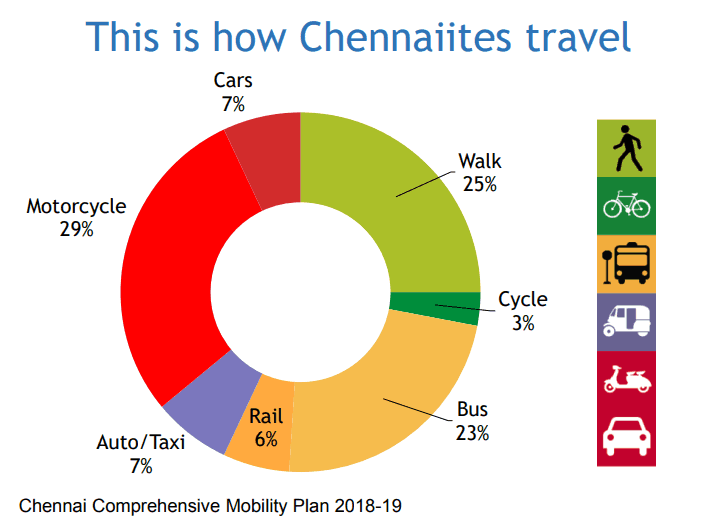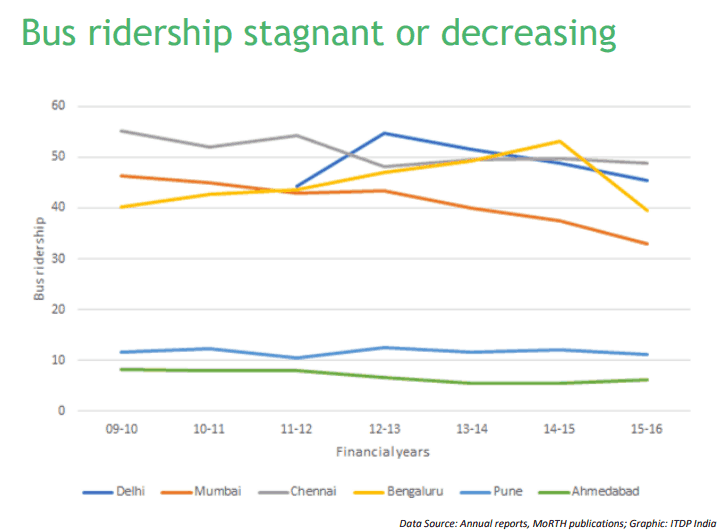Picture a Chennai where buses are the fastest and most regular means of transport for short distances. Where bus stops are seamlessly aligned and you won’t ever have to run after a bus that has overshot its designated stop or has come to a halt a good few metres before the stop. You don’t ever have to haggle with the conductor over small change, because you can purchase your ticket prior to boarding. Wouldn’t you automatically opt for a bus in such a scenario, instead of stressing yourself out at the driver’s wheel in the midst of crazy traffic?
Well, that precisely is the potential that a Bus Rapid Transit System holds for the city and the average commuter, according to mobility experts at the Institute for Transportation and Development Policy (ITDP).
Public transport infrastructure in Chennai is comprised of a variety of modes. Buses, suburban rail and the more recent addition, the metro rail, provide Chennaiites options for mobility across the city. However, each of these modes has had its own shortcomings, resulting in a rise in private vehicles and an exclusionary environment for those who cannot afford high fares. Suburban rail and metro networks have been meeting the transport needs of a section of the people, but buses still dominate the landscape. A robust bus network is thus necessary for efficient last mile connectivity that will supplement other means of transport. To this end, Chennai is exploring the introduction of a Bus Rapid Transit System (BRTS) in the city.
What is BRTS?
Bus Rapid Transit System, BRTS in short, involves the creation of dedicated corridors across the city for high-speed bus networks that aim to reduce traffic congestion and increase the number of commuters using buses in the city. The corridors will be exclusively used by buses, with terminals and ticketing stations created along the existing high-traffic routes. According to the US Federal Transit Administration, such corridors improve bus speeds, making it a viable and attractive means of commute for the people, combining the speed of rail transit and the flexibility of buses.
BRTS designed according to the BRT Standard, created by global leaders in bus transport design, will put buses on the fast lane and have features such as platform level boarding and off-board ticketing to reduce time taken to board and deboard by almost 80%.
The system is also cost efficient, with Rs 1500 crores required to created a 67-km world class BRTS corridor as against a 5-km stretch of metro rail or a 6.7-km stretch of monorail network, according to researchers at the Institute for Transportation and Development Policy (ITDP).
“Our cities can no longer afford to build more roads, whether it be in the form of flyovers or road expansions,” said Sivasubramaniam J, Manager Transport Systems, the Institute for Transportation and Development Policy (ITDP) India Programme, speaking on the cost-effectiveness and capacity of the BRTS, “Building more road infrastructure does not increase the actual capacity of the road. An elevated two-lane flyover can carry 2400 people per hour in each direction, which costs our city over 200-300 crores per kilometer. A BRT system can carry anywhere between 10,000 – 40,000 people per hour in each direction at a cost of about 20 crores per km, a tenth of the cost of a flyover.”
BRTS in Chennai
Among the public transport available, buses see a high level of patronage in Chennai, comprising 23% of the modal share of transport according to the Comprehensive Mobility Plan for Chennai 2018 – 2019. This is much higher than the rail network being used by just 6% of the population.
However, failure to upgrade the bus network, in addition to the fare hike in 2018, has caused a drop in bus ridership, while personal vehicles continue to dominate the landscape.
According to the same study, two-wheelers and cars accounted for 36% of the share of transport vehicles in the city. With the rise in share of such modes, the city battles traffic congestion and there is a pricing out of sections of the population that cannot afford personal vehicles, resulting in alarming increase in vehicular emissions in the city.

Modal share of transport shows that there is a high use of private vehicles in the city. Graphic: ITDP
In the offing
The proposed BRTS network will cover seven key sections of the city including GST Road, OMR, Koyambedu, Thoraipakkam and Chromepet. The routes will cover a total length of 120 kms, with a dedicated fast lane for buses in the centre. Bus speeds are expected to go up from 10kms/hr to 30kms/hr as a result of the changes to be introduced. A bus stop is planned every 600m.
In order to ensure convenience for the people, no existing bus stop locations will be changed. The width of the bus lanes will be between 30 m and 60 m depending on the width of the roads. Off-board ticketing counters along the lines of railway stations will also be introduced, thus helping in reduction of travel time.
The BRTS system will however require procurement of close to 2000 BRT-compatible buses. The current fleet of buses in Chennai that are ageing will not be suitable for features of the BRTS such as platform level boarding.
Getting past scepticism
With the transport authorities looking to introduce the BRTS in Chennai, dedicated public hearings were held across seven locations for people to engage with the idea and voice their questions and concerns. At the hearing at Jai Nagar Community Hall, Arumbakkam for the Koyambedu-Poonamalle stretch, K Rajamanickam of iMacs Consultancy Service engaged by the transport corporation fielded questions regarding the BRTS.
Questions from the general public mostly focused on the feasibility of such a system for the city, including clarifications on the width of the roads and the ability of private vehicles to use BRTS lanes. K Rajamanickam clarified that the roads in the city are wide enough for dedicated corridors and the system will go a long way towards easing of traffic congestion, which has been a key concern in the Koyambedu area.
Not all residents were welcoming of the move, however; attendees of the hearing at OMR expressed reservations about the state of pedestrians in the face of plans to create a metro rail line and a BRTS system along the route. The attendees also raised questions on the pricing of the tickets under BRTS and if price differentiation from the metro would indeed be sufficient enough for users to choose buses over the planned metro rail route.
Challenges in implementation
The challenges that can be anticipated in Chennai include the need to upgrade an ageing fleet of buses to be BRTS- compatible, with the city already falling short of the necessary number of buses required for its population (by close to 2000).
Even if they were to be introduced, the maintenance of these buses could be a potential problem area once the corridors are operational, especially in light of the MTC scrapping Air Conditioned buses due to non-availability of spare parts.
The task of achieving seamless coordination between various agencies to ensure that planning and implementation are not scuppered is another area that could pose some hurdles.
While there is optimism about the BRTS, the example of cities such as Pune must serve as a cautionary tale. The Pune BRTS launched 12 years ago stares at a shortage of buses today, poor maintenance of the BRT corridors, digital signal boards and automatic doors, poor monitoring of signals and increasing operational costs. One hopes that Chennai will plan better and take the necessary precautionary steps to avoid a similar fate for its BRTS.

Once again we have depends on Diesel bus why can implement this idea with tram which is capable of runs in electrical which in old days which will be operational cost will low only implementation cost will be little higher
Oh my god. Please yes. On the one hand it will make buses efficient means of pre-last mile transportation, more reliable in terms of time and drastically reduce accidents.
The object and purpose of having BRTS as one mode of public transport rather transit must be well understood by all officials. It is not a magic lantern to reduce traffic congestion on the day it is introduced. Unless it attracts passengers using personalised transport modes into BRTS it will not reduce congestion.
For this at road intersections BRTS buses must get priority. BRTS lanes must be dedicated only to BRTS buses. Ordinary buses should not use that lane. No question of VIP or VVIP vehicles entering BRTS lane. Seamless transfer must be ensured for passengers
Last mile connectivity must be enabled. A SPV may be floated for this. Legislation to ensure the above must br enacted.
The operator must ensure high frequency and attractive journey time.
Electric buses may be considered for BRTS buses.
Pune BRTS is an utter flop. So Chennai administration should not go for it. Reserving a portion of road exclusively for bus or a separate bus corridor will severely affect other traffic. The pie chart only shows some mode of transport. What about Meen body vandi,mini vans,chartered bus, school and college buses, office buses? Life will become a nightmare. For God’s sake, no BRTS in Chennai. What happened to Volvo buses? All swaha done by politicians. No money to repair. So the PTC had to cannibalize good buses to run others.We don’t want any fancy ideas. Please strengthen existing bus routes..Ensure timely buses at stops, make buses with Power steering,provide good seats for drivers, make automatic ticketing. That itself is sufficient
The best way to promote common travel in Chennai is to cancel all licences given to auto drivers and this service should be taken over by govt.. haggling with them for reasonable fare is the worst experience due to which one doesn’t want to travel by bus or train and use auto services for last mile connectivity… They are the most greedy guys…
40 to 50% of autos belong to police, ward members, councillors,politicians. That’s why you don’t see them driving with meter. Good that Ola stepped in this space. At least hardworking drivers still can earn their livelihood